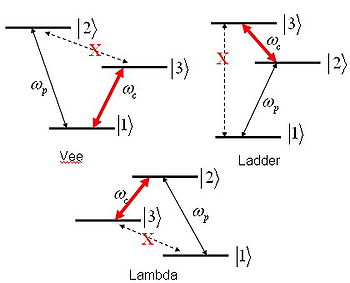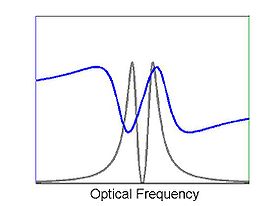
Electromagnetically induced transparency
Encyclopedia

Coherence (physics)
In physics, coherence is a property of waves that enables stationary interference. More generally, coherence describes all properties of the correlation between physical quantities of a wave....
optical
Optics
Optics is the branch of physics which involves the behavior and properties of light, including its interactions with matter and the construction of instruments that use or detect it. Optics usually describes the behavior of visible, ultraviolet, and infrared light...
nonlinearity which renders a medium transparent over a narrow spectral
Spectrum
A spectrum is a condition that is not limited to a specific set of values but can vary infinitely within a continuum. The word saw its first scientific use within the field of optics to describe the rainbow of colors in visible light when separated using a prism; it has since been applied by...
range within an absorption line. Extreme dispersion
Dispersion (optics)
In optics, dispersion is the phenomenon in which the phase velocity of a wave depends on its frequency, or alternatively when the group velocity depends on the frequency.Media having such a property are termed dispersive media...
is also created within this transparency "window" which leads to "slow light
Slow light
Slow light is the propagation of an optical pulse or other modulation of an optical carrier at a very low group velocity. Slow light occurs when a propagating pulse is substantially slowed down by the interaction with the medium in which the propagation take place.Researchers at the Rowland...
", described below.
Observation of EIT involves two optical fields (highly coherent light sources, such as laser
Laser
A laser is a device that emits light through a process of optical amplification based on the stimulated emission of photons. The term "laser" originated as an acronym for Light Amplification by Stimulated Emission of Radiation...
s) which are tuned to interact with three quantum states of a material. The "probe" field is tuned near resonance between two of the states and measures the absorption spectrum of the transition. A much stronger "coupling" field is tuned near resonance at a different transition. If the states are selected properly, the presence of the coupling field will create a spectral "window" of transparency which will be detected by the probe. The coupling laser is sometimes referred to as the "control" or "pump", the latter in analogy to incoherent optical nonlinearities such as spectral hole burning or saturation.
EIT is based on the destructive interference of the transition probability between atomic states. Closely related to EIT are coherent population trapping (CPT) phenomena. EIT is a coherently prepared media which has long quantum memory
Material requirements

Also important are the dephasing rates of the individual states. In any real system at finite temperature there are processes which cause a scrambling of the phase of the quantum states. In the gas phase, this means usually collisions. In solids, dephasing is due to interaction of the electronic states with the host lattice. The dephasing of state |3> is especially important, ideally |3> should be a robust, metastable state.
Current EIT research uses atomic systems in dilute gasses, solid solutions, or more exotic states such as Bose-Einstein condensate. Work is also being done in semiconductor nanostructures such as quantum well
Quantum well
A quantum well is a potential well with only discrete energy values.One technology to create quantization is to confine particles, which were originally free to move in three dimensions, to two dimensions, forcing them to occupy a planar region...
s, quantum wire
Quantum wire
In condensed matter physics, a quantum wire is an electrically conducting wire, in which quantum effects are affecting transport properties. Due to the quantum confinement of conduction electrons in the transverse direction of the wire, their transverse energy is quantized into a series of...
s and quantum dots.
Theory
EIT was first proposed theoretically by professor Jakob Khanin and graduate student Olga Kocharovskaya at Gorky State University (present: Nizhnij Novgorod), Russia http://www.spaceref.com/news/viewpr.html?pid=3722; there are now several different approaches to a theoretical treatment of EIT. One approach is to extend the density matrixDensity matrix
In quantum mechanics, a density matrix is a self-adjoint positive-semidefinite matrix of trace one, that describes the statistical state of a quantum system...
treatment used to derive Rabi oscillation of a two-state, single field system. In this picture the probability amplitude
Probability amplitude
In quantum mechanics, a probability amplitude is a complex number whose modulus squared represents a probability or probability density.For example, if the probability amplitude of a quantum state is \alpha, the probability of measuring that state is |\alpha|^2...
for the system to transfer between states can interfere destructively
Interference
In physics, interference is a phenomenon in which two waves superpose to form a resultant wave of greater or lower amplitude. Interference usually refers to the interaction of waves that are correlated or coherent with each other, either because they come from the same source or because they have...
, preventing absorption. In this context, "interference" refers to interference between quantum events (transitions) and not optical interference of any kind. As a concrete example, consider the lambda scheme shown above. Absorption of the probe is defined by transition from
 to
to  . The fields can drive population from
. The fields can drive population from  -
- directly or from
directly or from  -
- -
- -
- . The probability amplitudes for the different paths interfere destructively. If
. The probability amplitudes for the different paths interfere destructively. If  has a comparatively long lifetime, then the result will be a transparent window completely inside of the
has a comparatively long lifetime, then the result will be a transparent window completely inside of the  -
- absorption line.
absorption line.Another approach is the "dressed state
Light dressed state
In the fields of atomic, molecular, and optical science, the term light dressed state refers to a quantum state of an atomic or molecular system interacting with a laser light...
" picture, wherein the system + coupling field Hamiltonian
Hamiltonian (quantum mechanics)
In quantum mechanics, the Hamiltonian H, also Ȟ or Ĥ, is the operator corresponding to the total energy of the system. Its spectrum is the set of possible outcomes when one measures the total energy of a system...
is diagonalized and the effect on the probe is calculated in the new basis. In this picture EIT resembles a combination of Autler-Townes splitting and Fano interference between the dressed states. Between the doublet peaks, in the center of the transparency window, the quantum probability amplitudes for the probe to cause a transition to either state cancel.
A polariton
Polariton
In physics, polaritons are quasiparticles resulting from strong coupling of electromagnetic waves with an electric or magnetic dipole-carrying excitation. They are an expression of the common quantum phenomenon known as level repulsion, also known as the anti-crossing principle...
picture is particularly important in describing stopped light schemes. Here, the photons of the probe are coherently "transformed" into "dark state polaritons" which are excitations
Excited state
Excitation is an elevation in energy level above an arbitrary baseline energy state. In physics there is a specific technical definition for energy level which is often associated with an atom being excited to an excited state....
of the medium. These excitations exist (or can be "stored") for a length of time dependent only on the dephasing rates.
Slow light and stopped light

Slow light
Slow light is the propagation of an optical pulse or other modulation of an optical carrier at a very low group velocity. Slow light occurs when a propagating pulse is substantially slowed down by the interaction with the medium in which the propagation take place.Researchers at the Rowland...
. The Kramers–Kronig relations dictate that a change in absorption (or gain) over a narrow spectral range must be accompanied by a change in refractive index over a similarly narrow region. This rapid and negative change in refractive index produces an extremely low group velocity
Group velocity
The group velocity of a wave is the velocity with which the overall shape of the wave's amplitudes — known as the modulation or envelope of the wave — propagates through space....
. See for this the comprehensive review on this subject in. The first experimental observation of the low group velocity produced by EIT was by Boller, Imamoglu
Ataç Imamoglu
Ataç İmamoğlu is a Turkish physicist working on quantum optics and quantum computation. His academic interests are quantum optics, semiconductor physics, and nonlinear optics.-Education:...
, and Harris at Stanford University in 1991 in strontium
Strontium
Strontium is a chemical element with the symbol Sr and the atomic number 38. An alkaline earth metal, strontium is a soft silver-white or yellowish metallic element that is highly reactive chemically. The metal turns yellow when exposed to air. It occurs naturally in the minerals celestine and...
. The current record for slow light in an EIT medium is held by Budker, Kimball, Rochester, and Yashchuk at U.C. Berkeley in 1999. Group velocities as low as 8 m/s were measured in a warm thermal Rubidium
Rubidium
Rubidium is a chemical element with the symbol Rb and atomic number 37. Rubidium is a soft, silvery-white metallic element of the alkali metal group. Its atomic mass is 85.4678. Elemental rubidium is highly reactive, with properties similar to those of other elements in group 1, such as very rapid...
vapor.
Stopped light, in the context of an EIT medium, refers to the coherent transfer of photons to the quantum system and back again. In principle, this involves switching off the coupling beam in an adiabatic fashion while the probe pulse is still inside of the EIT medium. There is experimental evidence of trapped pulses in EIT medium.
In authors created stationary light pulse inside the atomic coherent media. In 2009 researchers from Harvard University and MIT demonstrated few-photon optical switch for quantum optics based on the slow light ideas
Primary work
- O.Kocharovskaya, Ya.I.Khanin, Sov. Phys. JETP, 63, p945 (1986)
- K.J. Boller, A. Imamoglu, S.E. Harris, Physical Review Letters 66, p2593 (1991)
- Eberly, J. H., M. L. Pons, and H. R. Haq, Phys. Rev. Lett. 72, 56 (1994)
- D. Budker, D. F. Kimball, S. M. Rochester, and V. V. Yashchuk, Physical Review Letters, 83, p1767 (1999)
- Lene Vestergaard Hau, S.E. Harris, Zachary Dutton, Cyrus H. Behroozi, Nature v.397, p594 (1999)
- D.F. Phillips, A. Fleischhauer, A. Mair, R.L. Walsworth, M.D. Lukin, Physical Review Letters 86, p783 (2001)
- Naomi S. Ginsberg, Sean R. Garner, Lene Vestergaard Hau, Nature 445, 623 (2007)
Review
- Harris, Steve (July, 1997). Electromagnetically Induced Transparency. Physics Today, 50 (7), pp. 36–42 (PDF Format)
- Zachary Dutton, Naomi S. Ginsberg, Christopher Slowe, and Lene Vestergaard Hau (2004) The art of taming light: ultra-slow and stopped light. Europhysics News Vol. 35 No. 2
- M. Fleischhauer, A. Imamoglu, and J. P. Marangos (2005), "Electromagnetically induced transparency: Optics in Coherent Media", Reviews Modern Physics, 77, 633

